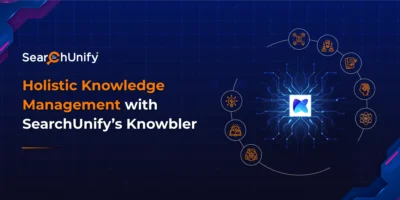
Knowledge is power, but only if it is shared. This is why organizations emphasize knowledge management. An efficacious KM program ameliorates self-service, reduces employee effort, improves customer onboarding, drives support ROI, and the list goes on.
Fun Fact: As per TSIA, employee-facing and customer-facing knowledge programs get an average rating of a measly 5.5 out of 10.
Is your KM program also facing headwinds? Let’s find out what’s standing in the way of your KM nirvana.
Top Challenges Impeding the Successful Adoption of Your KM Program
Embracing KM programs becomes a cakewalk when you are well up on the following challenges; because you can’t change what you don’t know:
1. Lack of a Knowledge Sharing Culture:
Knowledge sharing culture can make or break your KM initiative. The two prime reasons that stand in the way of its successful implementation are:
- Resistance to change: People are petrified of change; especially when they are unaware or skeptical of the outcomes. That is why managing resistance to change can be challenging. But being mindful and transparent about the reason behind the change can turn the odds in your favor.
- Information hoarding: Employees hoard information for multiple reasons, like the fear of undermining their expertise, job security, and getting the credit for the work or personal gain. But what if an employee leaves? Their knowledge and expertise leaves with them. That is why if you continue rewarding people for hoarding information rather than sharing it, you’ll have a hard time being successful.
2. No Dedicated KM Team:
KM programs don’t perform well with a fire-and-forget approach. They demand an all-hands-on-deck effort to keep them up and running. Once a plethora of data has been captured, it needs to be maintained to steer clear of duplication and redundancy. But who will oversee it?
It’s true that everyone must be accountable for knowledge management practices. However, when there is no one with the direct responsibility for the program, it doesn’t take long to turn “everyone is accountable” into “no one is accountable.” That is where a dedicated KM team can work wonders. Although everyone must contribute to the KM initiative, a team must be appointed to solely and efficiently manage knowledge.
3. Lack of Strategy to Streamline Dated Content:
How often do you review your knowledge management content to update or remove outdated or redundant pieces? Ultimately, the goal is quality, and not quantity. Imagine the efforts your KM team needs to put in to do it manually.
Fortunately, cutting-edge KM tools empower you to find and work on duplicate and redundant content in a jiffy. Arm your KM team with such tools. Else, you’d be implementing a new KM system every five years, beginning with the “rip and replace” cycle afresh.
4. Limited Insights to Bridge Gaps in the Knowledge Base:
The entire purpose of a knowledge base is defeated if users struggle to find answers to rudimentary issues. For example, your knowledge base is bombarded with content pertaining to the installation of the product. But it wasn’t updated when you upgraded the product. So, every time a user entered a product-related query, either the stale content was populated, or even worse, no results were generated at all. Results? Dissatisfied customers walking away from your brand.
State-of-the-art cognitive technologies today come with robust insights engines that give real-time insights on how the content is being consumed by users. With metrics like most-searched keywords, keywords with no results, and so on, you can identify the content gaps and update your knowledge base to bridge them. As a result, customer engagement stays on the boil and CSAT score increases magnificently.
5. Little to No Gamification:
Missing out on gamification while framing a KM strategy is a mistake. But rewarding employees on the basis of more addition to the KB is a blunder. Because when quantity looms large in the minds of knowledge workers, you end up collecting a lot of nugatory data in your knowledge base.
With real-time KB analytics, you can identify the most useful content. Based on who created, reviewed, and updated it, you can identify the top contributors and reward them. Furthermore, if you can get to the bottom of what these contributors are doing right, then you can capture their skills to train others do the same.
Looking for Ways to Overcome These Hurdles? Cognitive Technology is Your Go-To Solution!
Vyjayanthi Sreenivasan, Sr. Manager, Self-Help & Community, Automation Anywhere, had devised a robust framework for the company’s KCS initiative. But she needed a vantage point to analyze and amplify its effectiveness. This is where SearchUnify’s insights engine and app suite kicked in. The platform empowered her team with intelligent search and granular reports that helped monitor and ingrain KCS in Automation Anywhere’s ethos.
For a complete walkthrough of their journey, tune in to this webinar and listen from the horse’s mouth how they overcame KCS challenges with a like SearchUnify.



















